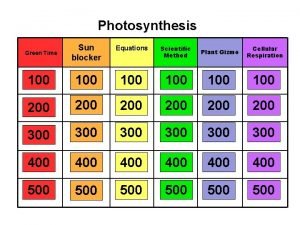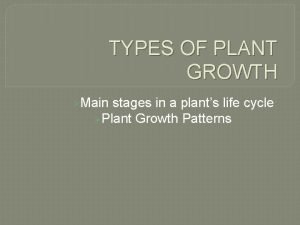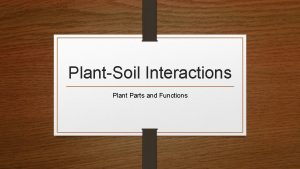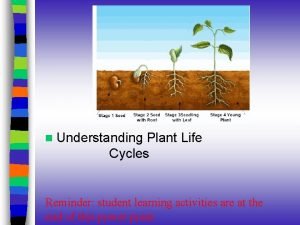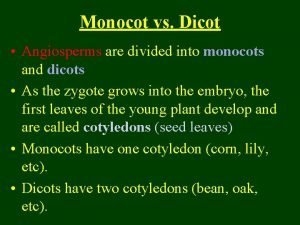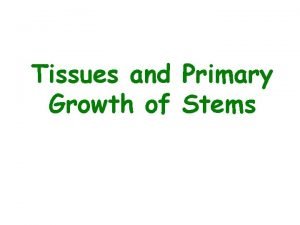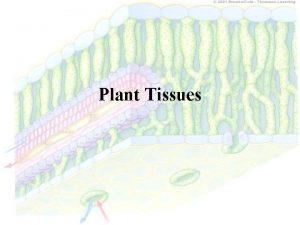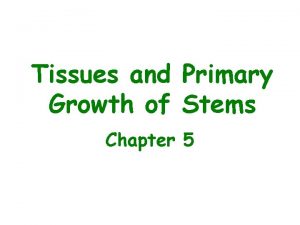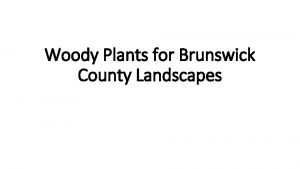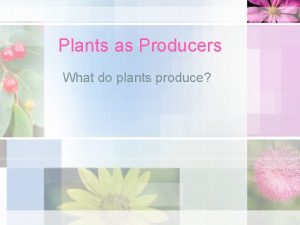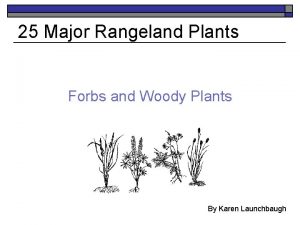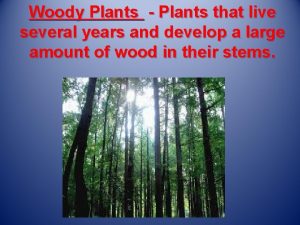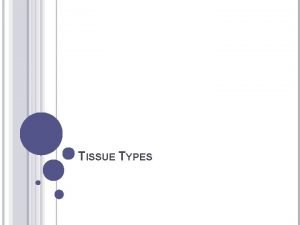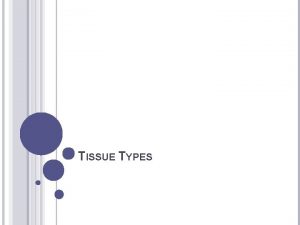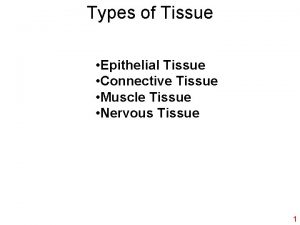SECONDARY GROWTH Concepts Woody plants produce secondary tissue


























- Slides: 26

SECONDARY GROWTH

Concepts: Woody plants produce secondary tissue. • Wood = secondary xylem • Bark = secondary phloem and cork

Advantages Ability to live through harsh conditions Once it is rooted, it has the ability to grow back and does not have to reseed They give the plant a greater number of vascular tissues to move water. Greater ability to move water and minerals up; carbohydrates down Each ring has more capacity than the previous ring Photosynthetic capacity increases Allows the plant to occupy a favorable site for years Provides strength and size advantages

Disadvantages Must fight disease for much longer Larger plants are bigger targets for pathogens Wood is “expensive” to produce—takes a lot of energy Reproductive maturity can be delayed for several years (or decades) Greater chance of death before reproduction

* Secondary growth has risen only 3 times (2 lines died out)—the woody plants of today began evolving about 370 mya. (Fig. 24. 4) * Secondary growth occurs in gymnosperms and dicots—not in ferns or monocots

VASCULAR CAMBIUM Meristem cells that produce secondary growth Divides longitudinally (anticlinal walls) Gives rise to secondary growth Secondary xylem—pushed toward the inside of the plant Secondary phloem—pushed to the outside of the plant Fusiform initials produce vessel elements and phloem Ray initials produce short cells used for storage


Vascular Bundles Primary growth- only 1 set of phloem and xylem Phloem- Carbohydrates and other photosynthetic materials are carried throughout plant—From Leaves Xylem- water and nutrients are carried throughout plant--From Roots Grow together in Vascular bundles

Monocots- Vascular bundles are scattered Dicots- Vascular bundles are in a ring

Secondary Phloem- Created by the vascular cambium. Pushed toward the outside of the stem Secondary Xylem- Created by the Vascular cambium. Pushed toward the insided of the stem Multiplicative division allows for continuous band around the stem. Additive division makes the stem thicker.


Secondary Xylem Answer questions 1 and 5 on page 227.

Secondary Xylem Hardwoodscontain large amounts of fiber, making them tough. Originate from dicots or deciduous trees Includes balsa (no fiber) Softwoods- Have less amounts of fiber making them softer. Originate from conifers or needle trees Rays are used to store material during dormancy and to transport material laterally for short distance

Annual Rings New xylem and phloem produced seasonallyforms the rings Tells the age of the tree Indicates good or bad growing season Older xylem toward the middle (inside) Early wood (Spring wood) First wood formed Must have high capacity to move water because leaves cuticle is not developed Late wood (Summer wood) Lower proportion of vessels for moving water because the cuticle is formed. Larger number of fibers to provide strength for the increased size of the plant

Heartwood Darker wood at center of tree Vessels of heartwood do not function any more due to breaking of the vessels from insects, vibration, etc. Plugs fill the vessels to prevent infection—TYLOSIS On average, one ring/year added to heartwood Sapwood Lighter colored rings Vessels are full of “xylem sap” (hence the name) Is this where maple syrup is found? One ring of sapwood added each year



Reaction Wood Also known as tension wood in hardwoods Gelatinous fibers in wood exert tension on the branch Prevents branches from drooping Rings are much wider at the top of the branch Also known as compression wood in conifers Enriched with lignin Rings much wider at the bottom of the branch

Secondary Phloem Also conducts up and down the stem Also derived from vascular cambium Outermost phloem is the oldest Secondary phloem conducts for less than one year (no rings) Rays of secondary phloem equal to those of xylem because they originate from same ray initial.

Outer Bark Secondary phloem develops into another cambium outside the vascular cambium = cork cambium (phellogen) Cork cambium produces the outer bark Outer bark made of cork cells (phellem cells) Phellem cells are dead, waterproof and fire resistant Phellem cells are constantly lost sloughed off like our skin Phellem = Cork = Outer Bark

Inner Bark “a dog’s conscience” All the phloem between the vascular cambium and the cork cambium. Lenticels are loosely packed cork cells that allow the diffusion of oxygen into the trunk. Included Phloem is phloem in secondary root tissue that is included in the xylem.


Homework



 Ground tissue
Ground tissue Primary growth and secondary growth in plants
Primary growth and secondary growth in plants Primary growth and secondary growth in plants
Primary growth and secondary growth in plants The food that plants produce during photosynthesis is
The food that plants produce during photosynthesis is Woody vs herbaceous
Woody vs herbaceous Woody vs herbaceous
Woody vs herbaceous Ernestine woody-bethune
Ernestine woody-bethune Kacie woody
Kacie woody Newton meets buzz and woody
Newton meets buzz and woody Stan woody
Stan woody Verkoopondersteuning winkelvloer communicatie
Verkoopondersteuning winkelvloer communicatie Woody stop motion
Woody stop motion Hss hypersonic sound
Hss hypersonic sound Stephanie clements
Stephanie clements Chris mollica
Chris mollica Crown plants examples
Crown plants examples Biennial crops examples
Biennial crops examples Ranunculus monocot or dicot
Ranunculus monocot or dicot Perforation plates
Perforation plates Interfascicular cambium is primary or secondary
Interfascicular cambium is primary or secondary What is bark
What is bark Plant tissue and organs
Plant tissue and organs Nonvascular plant
Nonvascular plant Vascular plants vs nonvascular plants
Vascular plants vs nonvascular plants Classify non flowering plants
Classify non flowering plants C3 plant
C3 plant Walnut cross section
Walnut cross section



